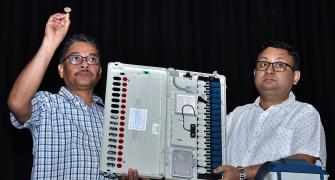Scientists of the Department of Aerospace Engineering at the Indian Institute of Science in Bangalore have developed a new innovative technology, which increases the range of Agni type of missiles.
The new technology will increases the range of the inter-continental missile by reducing the drag it encountered during its last flight on Wednesday.
'The drag was the main phenomenon, which dictates the range of the missile for a given amount of fuel, as the thrust generated by the rocket engine must compensate for the drag encountered by the missile in its path,' an IISc release said.
The nose of the missile was essentially blunted in order to reduce the heating problem, but the drag encountered by the blunt bodies when they travel at hypersonic speeds is larger. Hence, one way of increasing the range of the missile is to reduce the drag force, the release said.
Existing techniques for reducing the drag force involve addition of an aero-spike at the nose of the missile or blowing a supersonic gas jet from the missile nose tip. Implementation of these techniques involves major modification to the missile structure and hence cannot be applied to existing missiles which are in stockpile.
The new technology developed by Prof K P J Reddy and his team involves a radically different technique in the sense that no additional device or power is required for controlling the aerodynamic drag in the proposed technique during the actual hypersonic flight, the release said.
The release said a patent application has been filed on this technology. The technique was to coat the nose portion of the missile with a thin layer of a material like chromium. This metal coating evaporates due to the heating of the nose during its hypersonic flight and the evaporated metal particles in atomic form react exothermically with the oxygen atoms surrounding the body to release additional heat into the air in front of the missile.
This heat addition reduces the drag force up to about 47 per cent.
This method would ensure that without spending any additional energy the overall aerodynamic drag of the vehicle can be controlled and this in turn would improve the efficiency of the hypersonic flight of the vehicle.
The main advantages of this innovative hypersonic drag control techniques are it is a completely passive device that is non-intrusive and does not need any additional power during the actual flight to control the aerodynamic drag of the missile flying at hypersonic speeds and the amount of heat energy released into the shock layer of the body can be altered to suitably control the aerodynamic drag of the hypersonic.





